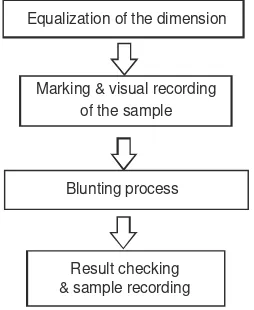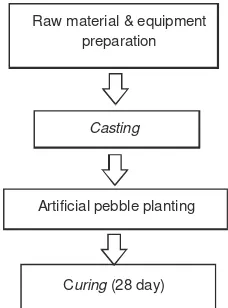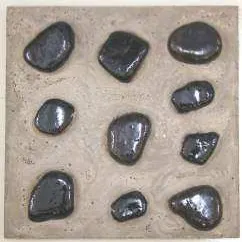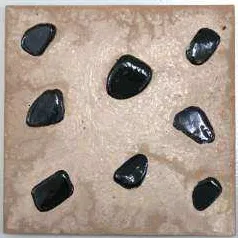107
Recycling Roof Tile Waste Material for Wall Cover Tiles
Ambar Mulyono
1*, Silfia Mona Aryani
1, and Joko Lulut
21. Interior Design Department, Letters and Visual Arts Faculty, Sebelas Maret University, Surakarta 57126, Indonesia 2. Fine Arts Department, Letters and Visual Arts Faculty, Sebelas Maret University, Surakarta 57126, Indonesia
*E-mail: ambarmulyono@uns.ac.id
Abstract
Prior research on roof tile waste treatment has attempted to find the appropriate technology to reuse old roof tile waste by create wall cladding materials from it. Through exploration and experimentation, a treatment method has been discovered to transform the tile fragments into artificial stone that resembles the shape of coral. This baked clay artificial stone material is then processed as a decorative element for vertical surfaces that are not load-bearing, such as on the interior and exterior walls of a building. Before applying the fragments as wall tiles, several steps must be taken: 1) Blunting, which changes the look of tile fragments using a machine created specifically to blunt the roof-tile fragment edges, 2) Closing the pores of the blunted fragments as a finishing step that can be done with a transparent coat or a solid color of paint, 3) Planting the transformed roof-tile fragments on a prepared tile body made of concrete. In this study, the second phase is done using the method of ceramics glazing at a temperature of 700 °C. The finishing step is the strength of this product because it produces a rich color artificial pebble.
Abstract
Daur Ulang Limbah Genteng sebagai Bahan Pelapis Dinding. Penelitian pengolahan limbah genteng yang telah dilakukan ini merupakan upaya penemuan teknologi tepat guna untuk memanfaatkan limbah pecahan genteng menjadi material finishing dinding. Melalui eksplorasi dan eksperimentasi ditemukan suatu metode pengolahan limbah genteng dengan cara mengubah pecahan genteng menjadi batu tiruan (artificial stone) yang menyerupai bentuk batu koral. Batu tiruan berbahan tanah liat bakar ini selanjutnya diolah sebagai material penghias pada permukaan vertikal yang tidak menerima beban seperti pada dinding interior dan eksterior. Sebelum diaplikasikan sebagai ubin pelapis dinding, tahapan yang harus dilakukan adalah: 1) Proses penumpulan (blunting), yakni mengubah raut pecahan genteng dengan alat yang diciptakan khusus untuk menumpulkan raut pecahan genteng. 2) Proses penutupan pori sebagai finishing yang dapat dilakukan dengan bahan transparan atau menggunakan bahan berwarna, 3) Penanaman pecahan genteng pada badan ubin semen. Dalam penelitian ini, pada tahap dua dilakukan dengan glaze keramik pada suhu 700 °C. Finishing
(penutupan pori) menjadi kelebihan dari produk ini karena menghasilkan koral tiruan yang kaya warna.
Keywords: artificial coral, blunting, recycling, roof-tile waste, wall cladding
1.
Introduction
There are many small and medium enterprises (SMEs) in Surakarta and its surroundings (known as Solo Raya) that produce variety products. These small industry has contributed in providing jobs and increased the district’s own source revenue by gaining taxes. One of the small industries in Solo Raya is the traditional roof tile industry. This industry can be found in Klaten, Wonogiri, Boyolali, Sukoharjo, and Karanganyar. Its demand is rising due to the recent growth of the property industry. Its product supplies most of the local market as well as some other areas in and outside of Java.
interior walls. Several steps conducted in this research are intended to formulate a beneficial form of roof tile waste recycling into wall cover tiles that meet three criteria: strength, aesthetics, and application of appropriate technology.
The selected raw materials for this research are roof tile waste from two productive industries in Solo Raya from Bekonang Sukoharjo and Klepu Klaten as well as roof tile waste collected by the scavengers primarily in Soka Kebumen. Each source of tile results in different characteristics in terms of strength and color, which affect the blunting process and the glaze finishing technique. The final goal of this study is to produce wall cover tiles with artificial coral made from blunted roof tile waste as decorative elements and tile mixtures made from the powder of destroyed roof tiles.
2.
Methods
The study is conducted as experimental research. The aim is to find an appropriate method for recycling roof-tile fragments as a creative approach to reusing building materials. Two main problems in the recycling process involve blunting the sharp edge of the fragments and treating large amounts of fragments. Therefore, this experiment may need a specific machine that works efficiently. To make it affordable, a machine was made using appropriate technology, and hence it can be made easily by craftsmen with a low budget to avoid additional operational expenses. Therefore, the appropriate method developed from this research was made by considering and applying simple technology with familiar tools and materials.
The research was conducted in two steps, which are described in the following sections.
Making the Blunting Machine and the Blunting Process. A study related to tile and brick waste processing machines was conducted by Munawir for the roof tile industry in Boyolali [1]. The redesign of a grinding machine that applies the QFD method aims to produce red cement. When compared with a blunting machine, it places more emphasis on the production of artificial pebble from tile fragments, although it also produces red cement (grog). Roof-tile fragments usually
designed to optimize the collision of the material and the walls of the grinding space. When roof-tile fragments were put into the machine and the machine was spinning, the fragments would collide with each other and the walls, blunting their sharp edges.
Machine design. The principle of the machine is to blunt the edges through collisions between the fragments and between the fragments and the walls of the grinding space. The machine was constructed of the following parts: blunting room in a hexagonal prism shape, supported frame, electric motor and circulate transmission, lever for hand rotation.
Construction equipment and materials: electric welding equipment, iron saw, ruler, electrical motor (250 watt; can be replaced with a former water pump), rubber (V Belt) for rotating transmission, transmission gear Ø: 10 inch (25 cm) and Ø: 13 inch (32.5cm), switch (ON/OFF button), metal plate with a 1.5-mm thickness, 4x4 angled iron with a 3-mm thickness (Figure 1).
Finishing equipment and material: compressor 1 HP, spray gun, lacquer paint, epoxy sealer, sandpaper. The blunting machine constructed of the abovementioned components was then used to test the blunting process of roof-tile fragment samples from Bekonang Sukoharjo, Klepu Klaten, and Soka Kebumen. The results of the blunting process were tested based on visual characteristics through several steps, which are explained in Figure 2.
Figure 1. The Prototype of the Blunting Machine
Equalization of the dimension
Marking & visual recording of the sample
Blunting process
Result checking & sample recording
Figure 2. Blunting Experimental Process
in principle to that used to make concrete; they are both made by mixing cement, aggregate, and water, but red Portland cement [2] (as much as 10%) is also used for roof tiles. During the mixing process, concrete is in a plastic condition so can be formed using a casting technique [3]. In this study, three alternative materials were mixed that led to tile with different visual appearances: Tile with white Portland cement, tile with grey Portland cement and red cement, tile with white Portland cement and red cement. The tile-making process can be explained in the diagram in Figure 3.
Curing (28 day)
Figure 3. Wall Cover Tile Experimental Process
Tile Materials (0.5 kg): portland cement = 50%, river sand Ø≤ 3mm = 43%, roof tile powder = 5%, nylon net 20x20 cm2, white cement, roof-tile fragments (for artificial coral), and Glue.
After the curing process, the visual appearance of casted tiles with three types of mixture was tested to evaluate the following characteristics: surface smoothness and the contrasting colors of the background and tile fragment colors (black and white glaze).
3.
Results and Discussion
Blunting Machine and the Results of the Blunting Process. The Machine’s operation. Roof-tile fragments of 2-6 cm2 were put in a grinding chamber that had to be locked before the spinning process began. To operate the machine electrically, the V-belt had to be installed on the transmission gear and the machine had to be locked with the left-side lever arms. After the machine was activated, the grinding part spun slowly (slower than motor spinning), causing a collision between roof-tile fragments and between the fragments and the chamber walls. This made the roof-tile fragments blunt and smooth. The blunting process took 20 minutes, and then the machine could be turned off to take out the blunting result.
Experimental results. The grinding experimental process was conducted by using fragments derived from three sources: (A) Klepu roof tiles; (B) Bekonang roof tiles; and (C) Soka roof tiles.
The size and smoothness of blunted roof-tile fragments are determined by the length of the grinding process. A longer grinding process makes smoother edges and redder powder. The best blunting process creates a flat and smooth surface that has a coral appearance.
In this blunting test, it was determined that the fragment only 1/3 of the machine capacity which means 20 kg of
To understand the differences in the blunting process, the outline of roof tiles was documented (Table 2), photographed, and numbered in samples before and after the process. Tiles from Bekonang seem to be more fragile and hence create smaller coral artificial. In addition, two samples (numbers 2 and 6) were 80% destroyed so they were not recorded after blunting. Soka roof-tile fragments created a better coral articifial, smoother edges, and a louder crashing sound during the blunting process. Table 2 below describes the changes in the outlines of roof tiles before and after the blunting process.
Wall Cover Tiles. This type of finishing material was chosen because of its realistic consideration, as wall cover does not have to support a construction load like floor cover and roof tile cover is not as strong as coral stone.
In tile making, roof-tile waste has a double function. In terms of its artificial coral appearance, it functions as a decorative element of a tile’s surface. Whereas as form of powder resulted from blunting process, it can be admixture of tile-base making.
The main obstacle of roof-tile fragments is their high porosity that requires a layer to cover their surface pores. Therefore, after achieving the desired form of fragments, they need to be covered with finishing layer. There are two methods that can be used to cover the fragments’ surface: 1) coating in transparent and solid coloring, 2) glazing with glass covering (glaze), which is usually used for ceramics glazing.
In the present experiment, the second method was used, as glaze is considered stronger, glossy, and waterproof. The glazing process in this research is similar to the usual methods involving surface covering with glaze
Table 1. Material Reduction after the Blunting Process
Table 2. Tile Fragment Changes Before and After the Process of Blunting
Before the blunting process After the blunting process
Klepu Roof Tiles
Bekonang Roof Tiles
Soka Roof Tiles
material that had been mixed with coloring material. After glaze covering, the fragments needed to be bake in a furnace until they reached 700°C. The chosen glaze material had a low melted temperature, as roof tiles are typically made by burning them at 600 °C for four hours [4]. The purpose is to avoid destroying the roof tiles and to make the glaze more strong and sticky. The furnace
used in this study was a modern one with the following specifications: fuel: gas; body and cover: fire brick covered with a 3-mm steel plate on the outside; shelves: 12-mm iron plates; homemade (no brand).
After being glazed, the materials for tile-making were prepared to have the following specific functions: a) Cement as a binding agent that integrated all materials to form solid tiles, b) River sand as a small aggregate to strengthen the mixture, c) Roof tile powder as an admixture as Pozzolan that tied Ca (OH)2 as a result of
hydras cement with water into C-H-S. Pozzolan can be added to concrete mixtures (up to 10% of the cement weight) to improve workability, to make tile more waterproof (reducing permeability), and to increase tile’s strength and protection from chemical threads [5]. d) Nylon net to put the roof-tile fragments in the expected order and to strengthen the tiles, e) Roof-tile fragments that look like coral stone and are colored as decorative elements for the tile surface.
Tile-making process. Tiles decorated with artificial coral can be made using a casting method; the prepared mixture is typically put in a 20x20 cm2 tile cast. In this experiment, after the mixture was put in the cast, the nylon net with the roof-tile fragments glued in the wanted order was put in the mixture with half of the coral inside the mixture to give it a three-dimensional
Figure 2. Type I; Tile Body Made of White Portland Cement, Surface Topping with Artificial Pebbles
Figure 4. Type III; Tile Body Made of White Portland Cement and 50% of Red Powder, Surface Topping with Artificial Pebbles
Table 3. Visual Quality Evaluation of Cement Tiles
Type of Mixture Criteria 1 Criteria 2 Total*
White cement 5 5 10
Grey and red cement 3 3 6 White and red cement 4 4 8 * Scale of quality: 1= very bad, 2= bad, 3= better, 4= good, 5= very good
texture. In one day, the tiles can be taken from the casting for a 28-day curing time to reach the maximum strength level of the tile.
Tile assessment. In this research, an assessment was conducted by evaluating the visual quality of three alternative mixtures. The results are explained in Table 3.
4. Conclusions
The most important part of this research is the idea of adding value to waste materials by developing appropriate machinery that can be used by the small roof tile industries widely found in villages. Visual processes such as coloring and the arrangement of
Future studies on these products can be done regarding design aspects, development opportunities, or the level of contribution in reducing CO2 emissions and
environmental damage.
References
[1] H. Munawir, R. Fitriadi, I. Satoto, Prosiding Simposium Nasional RAPI VIII, 2009, p.101.
http://publikasiilmiah.ums.ac.id/bitstream/handle/1 23456789/1896/15.%20Paper_I-022.pdf, 2013. [In Indonesia]
[2] Warsiti, E-Jurnal Wahana 12 (2007) 72. [In Indonesia]
[3] A. Lyons, Materials for Architects and Builders, Elsevier, British, 2007, p.440.
[4] H. Frick, Ch. Koesmartadi, Ilmu Bahan Bangunan Eksploitasi, Pembuatan, Penggunaan dan Pembuangan, Penerbit Kanisius, Yogyakarta, 1999, p.202. [In Indonesia]



